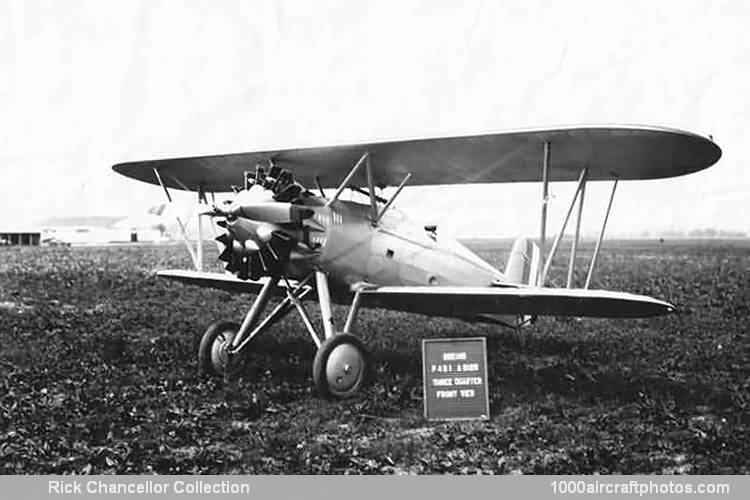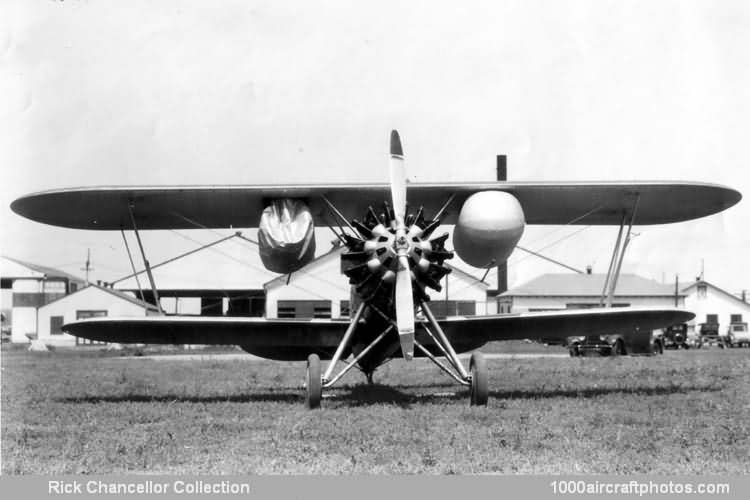05/31/2011. Remarks by
Johan Visschedijk: "Even as the modified XF3B-1 was being tested, Boeing saw opportunities for improvement; design of an entirely new model was laid down and the building of two company-financed prototypes was authorized which, in effect, sired the entire P-12/F4B range.
The two differed only in minor details of equipment but were given distinct Boeing designations, Model 83 and Model 89. External differences between them were the use of spreader-bar landing gear with diagonal strut bracing to the middle of the bar and arrester hook on the Model 83, whereas the Model 89 had split-axle tripod-type wheel gear and a 500 lb (227 kg) bomb-rack between the landing gear legs.
The chief merit of the new design was the fact that there was nothing radical about it. Every feature had been developed and proven on previous models – including even the unique bolted aluminum fuselage frame which was made up of square-section aluminum tubing. The customary practice of installing a larger engine in a new model to increase the performance was not necessary as the performance advance of the new design was achieved mainly through aerodynamic refinement and decreased structural weight.
Registered NX7133 (c/n 1039) the Model 83 was first flown at Seattle, Washington, on June 25, 1928 and after preliminary evaluation at NAS Sand Point, Seattle, it was delivered three days later to San Diego, California, for detailed evaluation by the Navy at various naval bases on the West Coast. The Model 89 was completed the following month and transported by rail to the Navy Test Center at NAS Anacostia on July 24th. Registered NX7134 (c/n 1040) it was flown for the first time on August 7, 1928, and subsequently tested at NAS Anacostia, and NAS Norfolk, Hampton Roads, Virginia.
Since both aircraft were Boeing-owned, neither bore military markings nor, strangely, did they carry the civil registrations allocated to them. Although not Navy property, they were referred to as XF4B-1s administratively and, while at San Diego, the Model 83 carried the markings "U.S. Navy" on the aft fuselage. Both aircraft were originally powered by "long-nosed" R-1340B engines which were supposed to improve the aerodynamic shape of the nose. They were however replaced by the standard C (or dash-7) engines with no more than marginal effect on the performance.
An order for 27 Model 99 F4B-1 fighter-bombers (A-8130 to A-8156) resulted from the Navy-testing of the two prototypes, later contracts brought the total of produced F4Bs to 187. While at NAS Anacostia, the Model 89 was loaned to and tested by Army pilots at Bolling Field (the Army installation across the field from the Navy facility), resulting in an order for ten similar Model 102 under the Army designation P-12, which production eventually totaled 366.
As a safety device, two flotation bags, inflated by bottled carbon dioxide, were carried in the upper wing just outboard of the center section struts.
To allow their deployment from the under surface of the wing (pictured above 25 seconds after release), the landing wires were lowered from their usual terminal points at the upper ends of the center section struts and attached to the upper longerons. This arrangement had been introduced on the F2B-1.
Both private venture prototypes were returned to Boeing and were refurbished to Model 99 F4B-1, the Model 83 on June 17, 1929, followed later by the
Model 89. They were purchased by the Navy as additional items, serialed
A-8129 and A-8128 respectively."


